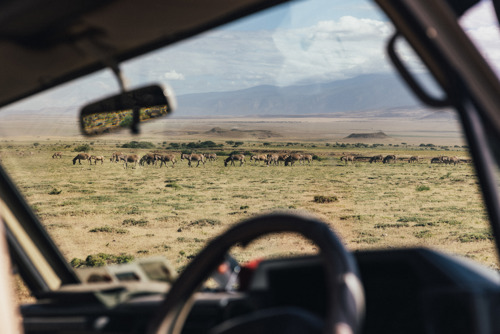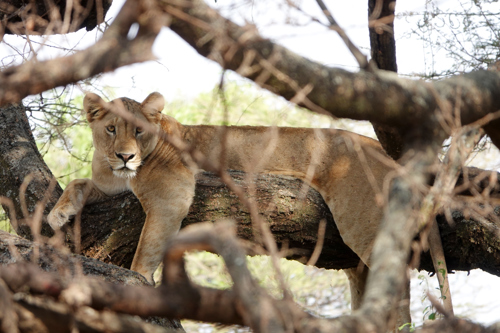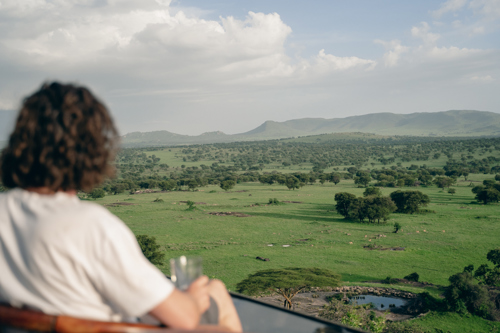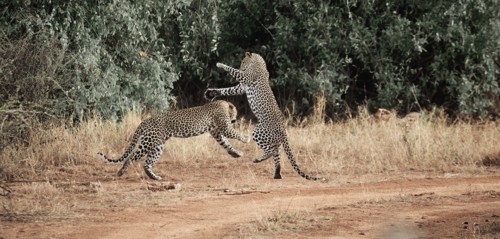Self-drive Serengeti | This is your ultimate travel guide
If you're planning a self-drive safari to Tanzania, we understand that the Serengeti National Park is likely at the top of your list. In this blog, we'll guide you through planning the ultimate Serengeti trip, offering plenty of tips and information for independent travellers and adventurous road-trippers. We'll cover driving times, permits and fees, the best times to visit, and more. Get ready to explore this world-class safari park with peace of mind and a lust for adventure!

Can I explore the Serengeti on a self-drive safari?
Yes, you can certainly explore the Serengeti on a self-drive safari! The Masai Mara and the Serengeti are probably the best-known safari parks in the world, and exploring these parks by yourself is a great adventure.
Most travellers enter through the Naabi Hill Gate, but beware—the road to Seronera, where most lodges are, can be a bumpy ride due to washboard surfaces caused by erosion. Keep a steady pace to navigate it smoothly, avoiding unnecessary shakes.
While professional driver-guides may speed through, it's advisable to take it slow as speeding can make the drive more challenging and even risky. If you're new to self-driving safaris, consider gaining confidence and experience in parks like Lake Manyara, Tarangire, or Ngorongoro before tackling the slightly more challenging Serengeti. Another option is to experience your Serengeti self-drive with a local driver-guide, who will take place behind the wheel and get you to your destination safely and without worries.
Driving times between Arusha and the Serengeti
Understanding the driving times is crucial for a smooth trip. Here's a breakdown:
- Arusha to Karatu (last town for groceries): 140 km in about 3,5 hours
- Karatu to Loduare gate (Ngorongoro Conservation Area entrance): 15 km in about 30 min
- Loduare gate to Ngorongoro crater entrance: 15 km in about 1 hour
- Ngorongoro Crater entrance to Naabi Hill Gate (Serengeti entrance): 85 km in about 2-3 hours
- Naabi Hill gate to Seronera (central part of Serengeti): 60 km in about 1 hour
- Seronera to Lobo Ranger post: 80 km in about 2 hours
- Return from Seronera to Arusha: 9-10 hours (not advised to drive in 1 day because road conditions can be bad)
Note: The last gas station before Serengeti is in Karatu, and there's an emergency station at Seronera (with higher fuel prices). Our safari vehicles are equipped with a large fuel tank (2x 80L), providing plenty of fuel for multiple days of game viewing without the risk of running out.
Exploring the Serengeti
Serengeti is part of a larger ecosystem, including Ngorongoro, Masai Mara, and smaller reserves. From Arusha, the most accessible parts of the Serengeti are its southern plains, comprising of Ndutu and Seronera. The western corridor and Lobo are rewarding too but far out. If you want to explore more off-the-beaten-track areas of the Serengeti, you might want to consider renting a car with a driver-guide. Our driver guides know the Serengeti inside out, and let you experience the park on a truly customised safari.
Alternatively, you can pick up a ranger from one of the gates to help you navigate the park better. Note that in this case, you are the only person allowed to drive our vehicle.
As Serengeti can't be reached in a day's drive from Arusha, it is best combined with the Ngorongoro Conservation Area, Tarangire National Park and/ or Manyara National Park. Have a look at our safari tours to find out which route suits you best.

Serengeti fees & permits
Managed by the Tanzania National Parks Authority (TANAPA), Serengeti permits can be arranged at the gate with a credit card. No prior reservations are needed. Cash is NOT accepted; neither are debit cards.
When travelling to the Serengeti, you'll pass through the Ngorongoro Conservation Area. To enter the Ngorongoro, a tour operator will have to arrange and issue your permit for you in advance. Roadtrip Africa is happy to help you organize your NCA reservation. Please select this option in our bookings form when renting your car. We charge a handling fee of € 25 in total.
For a clear overview of the entrance fees to Serengeti, Ngorongoro and other national parks in Tanzania, we gladly refer you to our Tanzania National Park Fees & Permits - page.
When to visit Serengeti - a month-by-month guide
The best time to visit the Serengeti is from January to February or June to October. However, the Serengeti’s density of wildlife offers a spectacular safari experience no matter what time of the year you visit. The park’s open plains and mild climate mean that vegetation is never too dense for spotting animals, and the region’s two short rainy seasons from November to December and March to April are rarely unpleasant.
-
Visiting the Serengeti from January to March
From January to March, the Serengeti comes alive with predictable game movements. This period marks the congregation of wildebeest and zebra in the Ndutu area, situated in the southeast corner of the park—a convenient spot for self-drivers from Arusha. Following the brief rains of early November, the herds migrate to the short-grass plains, indulging in the lush, nutritious grasses. These three months witness the majority of wildebeest calves being born, peaking around February, while predator concentrations reach their peak.
-
Travelling to the Serengeti from April to June
As April arrives, the Serengeti experiences a decline in visitor numbers, caused by the increased humidity and occasional heavy rainfall throughout May. June announces the start of the dry season, marking the ideal time to visit just before the peak safari season. This period is pivotal for the Great Migration, as the wildebeest embark on a northward journey of up to 40 km. The daring river crossing of the crocodile-rich Grumeti River unfolds from June to early July, with the initial herds facing higher risks. For this reason, it can take up to weeks from when the first wildebeest arrive at the southern banks of the river, for the actual crossing to begin. Tens of thousands of wildebeest congregate at the riverside, a truly spectacular sight! As the Western Corridor is far out from the main entrance to the Serengeti, we recommend travelling with our driver-guides to explore this section of the park.
-
Visiting the Serengeti from July to September
Many visitors flock to the Serengeti from July to September to witness the Great Migration. August is the absolute peak season and is considered the best time to witness the dramatic river crossings from the northern Serengeti into the Masai Mara. You'll likely see some of Africa’s big cats on the hunt!
September remains bustling in the Serengeti, particularly along the Kenyan and Tanzanian borders. The herds traverse the Mara River in smaller groups during this month, with the southern parts of the park offering a quieter respite.
-
Visiting the Serengeti from October to December
Although the Wildebeest Migration’s herds have made their way into Kenya during October, the Serengeti remains a spectacle for game viewing.
November introduces the "short rains," announcing a quieter, low season. The rain prompts fresh grasslands in the southern areas, enticing grazers. It's an ideal time for travellers to take advantage of lower hotel rates. By the end of November, the wildebeest herds start their southward migration, heading towards the Lobo section of the Serengeti.
Come December, the cycle starts all over again....

Guided or self-drive safari?
Travellers sometimes worry if they'll manage to spot big cats and other predators when choosing a self-drive safari.
Hiring a trained guide can undoubtedly increase your chances of wildlife sightings. Guides, equipped with walkie-talkies, engage in communication that helps with locating animals. However, this coordinated effort has a downside—multiple vehicles end up tracing each other's paths, resulting in a crowded and hurried experience, particularly during the already busy high season. This can compromise the true essence of the wilderness experience.
Going on safari is like a game of hide and seek between you and the animals. The feeling of reward you get when you spot them is like nothing else. If you ask us, there's a unique joy in exploring the Serengeti on your terms, independently locating animals and setting your own pace. Therefore, we'll always recommend booking a self-drive adventure, and not an organized tour.
Camping and lodges in the Serengeti
Visiting the Serengeti is not cheap. When it comes to accommodation, the most budget-friendly option is self-camping at public campsites. Close to Seronera Wildlife Lodge you'll find a cluster of seven campsites, with one public campsite located in the northeast, around the Lobo area. During the migration, the latter is a particularly good place to camp.
The Seronera campsites offer a large fenced cooking area and a separate roofed dining area. In our humble opinion, most of these campsites lack character and are primarily set up to cater for budget group safari tours. During peak season, you can expect to share the campsite with at least 40 other campers. Luckily, we did not experience this in the other safari parks in Tanzania. More information about camping in Tanzania can be found in our camping guide.
The best lodges in the Serengeti
If you stay in a lodge or Mobile Camp, expect to pay the following prices:
- Budget: US$300 - $400 for a double room, full board
- Mid Range: US$400 - $600 for a double room, full board
- Luxury: > US$600 for a double room, full board.
Taking off on your Serengeti self-drive adventure
Are you ready to rent a car and explore the Serengeti on a self-drive trip? Get in contact with our experienced team at Roadtrip Africa to check availability, and secure your 4x4 now!
